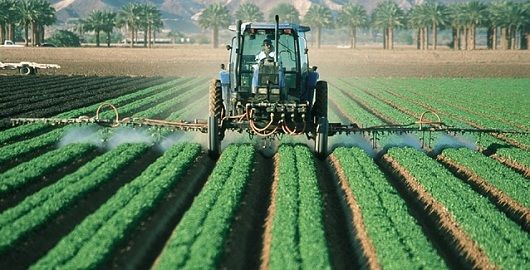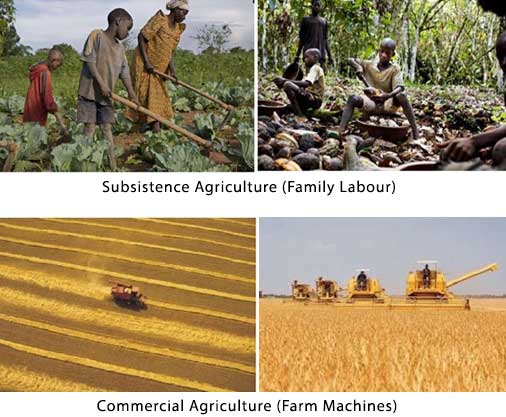The Duty of Innovation in Commercial Farming vs Subsistence Farming Approaches
The Duty of Innovation in Commercial Farming vs Subsistence Farming Approaches
Blog Article
An In-Depth Take A Look At the Challenges and Benefits of Modern Agriculture
Modern agriculture stands at the crossroads of innovation and sustainability, providing a wide variety of challenges and opportunities. With improvements like precision farming and biotechnology encouraging boosted productivity, the sector concurrently faces crucial problems such as ecological destruction and socio-economic differences. As we check out the intricate balance in between technical progress and its more comprehensive impacts, the concern develops: can we accomplish a sustainable future that profits both the atmosphere and farming areas? The path forward requires a mindful examination of these characteristics, inviting stakeholders to consider the possibility for transformative change in agricultural methods and plans.
Technological Developments in Farming
Technical advancements in farming have actually changed the agricultural field, driving enhanced efficiency and effectiveness. Technologies such as precision agriculture, biotechnology, and automation have transformed typical farming practices, enabling more lasting and profitable operations. Accuracy farming utilizes GPS modern technology, sensors, and information analytics to enhance field-level management regarding plant farming. This method enables farmers to use inputs like water, fertilizers, and chemicals extra judiciously, minimizing waste and reducing costs while improving returns.
Automation in farming has actually further driven the market ahead, with the intro of independent tractors, drones, and robotics. These modern technologies lessen labor demands and boost functional rate, enabling prompt growing and harvesting. Drones, in particular, provide beneficial aerial images and information, aiding farmers in keeping track of crop wellness and spotting issues early.
Biotechnology has likewise played an essential role in advancing farming methods. Collectively, these technical improvements have laid the foundation for an extra resilient and lasting farming future.
Ecological Challenges
Farming faces a number of ecological difficulties that threaten its sustainability and productivity. Among the primary problems is the destruction of soil health due to extensive farming techniques that deplete essential nutrients and lead to disintegration. The overuse of chemical plant foods and chemicals additionally intensifies this problem, infecting water sources and decreasing biodiversity. The lasting viability of agricultural land is compromised, requiring the fostering of more lasting methods.
Water scarcity is an additional substantial obstacle, specifically in areas where agriculture heavily depends on watering. Climate change is increasing this issue, changing rainfall patterns and boosting the frequency of dry spells. Reliable water administration systems, such as drip irrigation and rain harvesting, are crucial to reduce these effects, yet their execution remains unequal throughout different areas.
Additionally, agriculture is both a contributor and a sufferer to environment modification. It represents a considerable share of greenhouse gas emissions, mainly from livestock manufacturing and rice growing. Transitioning to low-emission farming methods, such as precision farming and agroforestry, can help in reducing this effect. These techniques need substantial investment and technical expertise, posturing a barrier to extensive adoption. Addressing these environmental obstacles is important for making certain a sustainable agricultural future.

Economic Influences
The financial influences of contemporary farming are diverse and extensive, affecting both regional and international markets. Breakthroughs in modern technology and manufacturing approaches have dramatically boosted farming performance, bring about more effective food supply chains and reduced prices for consumers. This enhanced performance has actually made it possible for nations to meet growing demands, support food rates, and add to financial development. Furthermore, the export of farming commodities has become a considerable source of earnings for many countries, playing an important function in their economic advancement.
Nonetheless, these advantages are not without obstacles. The capital-intensive nature of modern-day agriculture calls for substantial investment in machinery, plant foods, and genetically customized seeds, which can be economically troublesome for small-scale farmers. This frequently causes boosted financial debt and financial vulnerability, potentially resulting in the combination of farms and the loss of country incomes. In addition, global market changes can affect the earnings of farming exports, making economic situations reliant on agriculture prone to economic instability.
In addition, aids and trade plans in established nations can misshape market rates, influencing affordable balance and possibly disadvantaging farmers in creating countries. Overall, while modern farming drives economic development, it also necessitates browsing complex you can try this out economic landscapes to ensure equitable and lasting advancement.
Social Effects
While modern-day agriculture has actually brought around substantial improvements, it also presents various social effects that necessitate factor to consider. One major issue is the displacement of small farmers as a result of the increase of big agricultures. As company farming entities increasingly dominate the farming landscape, smaller sized farms usually have a hard time to compete, leading to the disintegration of country areas and traditional farming techniques. This shift can cause a loss of local knowledge and cultural heritage that smaller sized farms maintain.

Such practices might likewise limit customer selections and minimize the ability of neighborhood communities to regulate their food resources. As these social implications unravel, it comes to be crucial to resolve them to make sure lasting and equitable farming growth.
Future Directions
Looking in advance, a number of promising methods for contemporary agriculture might deal with the obstacles dealt with today while fostering lasting growth. Developments in modern technology, such as precision farming, offer the prospective to enhance resource usage and rise efficiency.
Biotechnology likewise holds tremendous assurance for the future of farming. Genetically customized organisms (GMOs) and gene editing and enhancing methods, like CRISPR, can enhance plant strength versus climate modification, pests, and diseases, thus improving food safety and security. Diversifying crop selections to consist of more nutrient-dense and climate-resilient alternatives might bolster both ecological stability and human nourishment.

Conclusion
Modern farming, defined by technical developments, provides both possibilities and challenges. commercial farming vs subsistence farming. Attending to these complexities calls for a transition towards sustainable techniques that stabilize performance with environmental stewardship and social equity, thereby making sure a resilient future for international agricultural systems.
Modern agriculture stands at the crossroads of advancement and sustainability, presenting a wide variety of chances and difficulties. Additionally, visit their website worldwide market fluctuations can affect the earnings of agricultural exports, making economic situations reliant on agriculture vulnerable to financial instability.
In addition, the extensive usage of innovation and automation in farming has actually led to a decrease in agricultural employment chances.Looking ahead, several encouraging opportunities for contemporary farming might resolve the challenges encountered today while promoting sustainable growth. commercial farming vs subsistence farming.Modern farming, characterized by technological developments, offers both difficulties and chances
Report this page